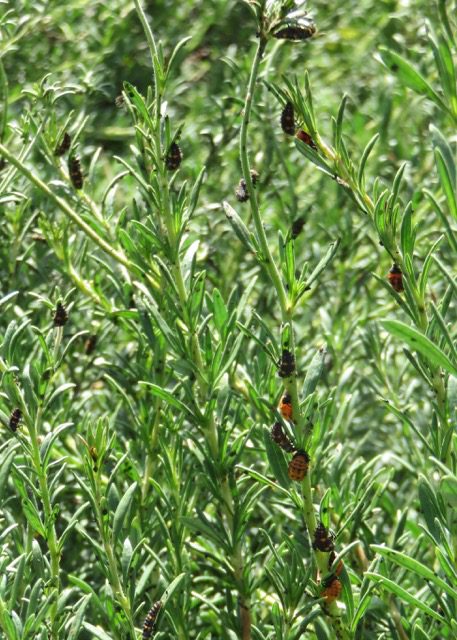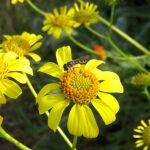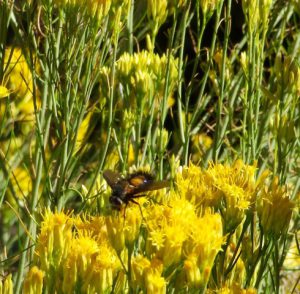I recently attended an all-day workshop on Habitat Gardening that covered our birds and butterflies and pollinators. It also focused on how to welcome beneficial insects to combat pests, therefore avoiding the use of pesticides.
Led by Frederique Lavoipierre, Director of Education at the Santa Barbara Botanic Garden, I came away with a deeper appreciation of our little garden guests. I’ll address beneficial insects in general in this column, and deal with butterflies and bees and the best plants to have next week.
Insects – Important and Underappreciated
The insect world is immense, as evidenced by it being classified into 30 different orders, too much to delve into here. The biggest takeaway from Lavoipierre is people are much too afraid of insects, and don’t realize the important role they play.
Here are a few examples. If you want to avoid or lessen pesticide use, you need to have insects around that eat pests. “Most pests got to be pests because they came from plants from other countries, and they didn’t come along with their natural predators,” Lavoipierre said, but in most cases local insects will come to the rescue.
Another example is remembering that our beautiful butterflies were caterpillars first, and during that important larval stage they do munch on our plants, but they’re also necessary to for feeding birds and especially baby birds.
Some important things I learned about insects:
- Don’t disturb the soil. Every single particle in the soil is covered with life, ranging from our common pillbugs that decompose the litter to micro ones only seen with a microscope. The most important and active layer is where soil and leaf litter meet – this is where the larva of beneficial insects such as soldier flies and ground beetles live. Lavoipierre recommends letting the natural mulch accumulate under shrubs and trees.
Did you know two handfuls of undisturbed native soil contain more living organisms than the human population? -Frederique Lavoipierre
- It’s important to observe: Ladybug larva on our California buckwheat

Observe! It’s important to observe insects to learn about the different stages. For example, can you recognize the immature ladybug stages so you’re not inadvertently killing future ladybugs that will rid your plants of aphids?
- Plant plants that attract beneficial insects. To keep insects around that get rid of our pests, you need plants that support the predators of our common pests – whiteflies, scale, aphids, and treehoppers. Because natural predators evolved with plants, having California native plants in your landscaping will best attract them.

A potter wasp (Vespidae; Eumeninae) – here on Santa Cruz Island buckwheat -uses caterpillars as prey items. Even insects that can cause panic do beneficial things. Years ago, my husband and I got alarmed at wasps making a paper-like nest outside our garage. After we sprayed it down with a hose we discovered they were paper wasps that prefer caterpillars and keep down their populations. Did you know that dragonflies and damsel flies eat their body weight in mosquitos every day? In fact, they’re as effective as mosquito fish. “Also, people are afraid of spiders unnaturally,” said Lavoipierre. “Spiders eat may pests and also make up a large part of the food that birds feed their young.”Wasps such as this native Potter wasp (here on Santa Cruz Island buckwheat) can be effective caterpillar predators.
- Allow places for insects to overwinter. For example, leave a couple old sunflower heads, and observe how they protect overwintering populations of beneficial insects like ladybugs and syrphidae flies – both effective aphid eaters. This means it’s also good to leave some aphids around. Don’t eradicate all of them, otherwise your beneficial insects fly off.

A hoverfly – an important predator of the Asian Citrus Psyllid – on Brittlebush. Pests have different life cycles than natural predators. Pests grow fast while their natural insect predators grow slow. Many natural predators go through different stages. Also, our beneficial insects are very sensitive to pesticides. Many people lean on pesticides because they give quick results, while waiting for the natural predators such as a ladybug to go through all their stages takes patience.
Plant-eating insects are good!
Many of us get concerned when we see leaves on our plants getting eaten. But Lavoipierre said insects that eat plants, called herbivorous insects, are especially important and are rarely discussed in horticulture. “One big reason bird populations are down dramatically is because we kill so many of the insects they depend on,” she said, explaining that nearly all birds (96%) feed insects to their young, and nearly three-fourths eat them as adults.
“Nearly all birds (96%) feed insects to their young, and nearly three-fourths eat them as adults.” –Frederique Lavoipierre
Another concern is the planting of so many non-native trees. Lavoipierre said we are unknowingly starving our birds with planting so many non-native-trees. The best trees for insects are trees that grew up here and have special relationships with bugs. According to Lavoipierre, a large native oak tree has — get ready — a whopping 800 species of insects, most of them caterpillars, that live in them. (One study showed California oak woodlands provide habitat for 5000 native insect species.)
“A whopping 800 species of insects (most of them caterpillars) live in a mature California oak tree. – Frederique Lavoipierre
“We don’t notice them because they eat at night,” she said. In comparison one survey on the ancient ginkgo tree that comes from China and has become popular, showed five caterpillar species.
Bump up natural predators with flowering plants
Planting a variety of flowering plants is very important to keep insects around, because many beneficial insects that prey on pests visit flowers. Next week I’ll provide a list of Lavoipierre’s top plants for pollinators. Lavoipierre reviewed the following groups of flowering plants as good ones to have in your yards.
- The Carrot family (Apiaceae) attracts many beneficial insects, especially parasitoid wasps and attract few pests; a negative is that many species are invasive.

Beneficial bugs on California goldenrod California goldenrod is a good flowering plant to consider for attracting native beneficial bugs
- The Daisy family (Asteraceae) has compound flowers that attract very small insects, and they bloom for long seasons. Consider yarrow and goldenrod.
- The Mint Family (Lamiaceae) attracts bees, with the flower size affecting the insect species it attracts. Consider lavender, mints, and culinary herbs like parsley.
- The Cabbage Family (Brassicaceae) attract many insects with its small flowers, but some like sweet alyssum can be invasive.
- Buckwheat (Erigonium) hosts many insects attracted by it small long-blooming flowers.
- Roses can be beneficial, with single or semi-double flowers offering easiest access.
- Grasses such as this deer grass provide good cover for beneficial bugs
Grasses provide early season pollen and provide habitat for ground dwelling predators such as beetles and spiders.
Resource list: Here is a list of recommended books and websites.
Next article– Attracting bees and other pollinators, butterflies, and top plants to plant



Leave a Reply